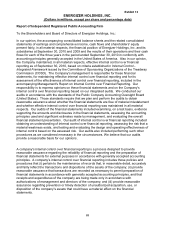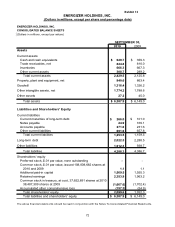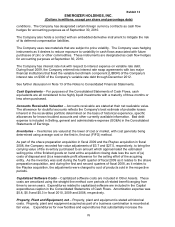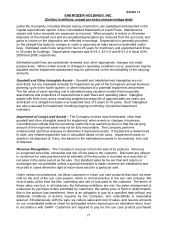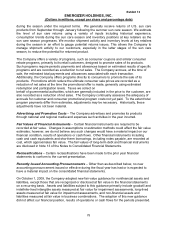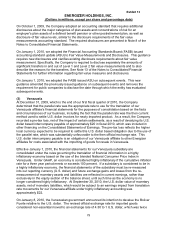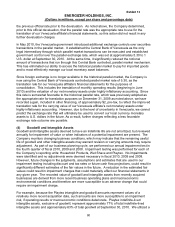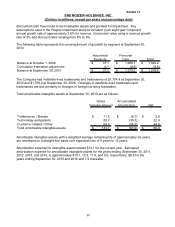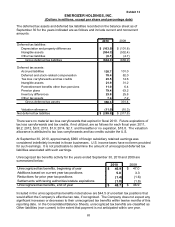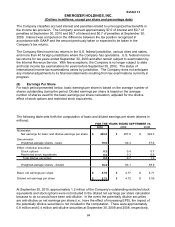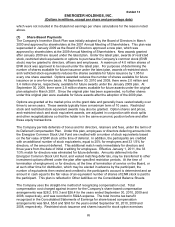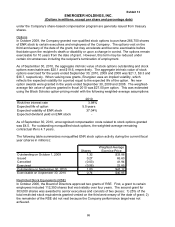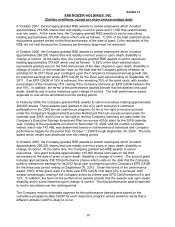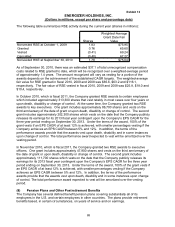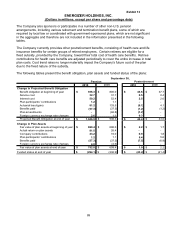Energizer 2010 Annual Report Download - page 89
Download and view the complete annual report
Please find page 89 of the 2010 Energizer annual report below. You can navigate through the pages in the report by either clicking on the pages listed below, or by using the keyword search tool below to find specific information within the annual report.
Exhibit 13
ENERGIZER HOLDINGS, INC.
(Dollars in millions, except per share and percentage data)
79
On October 1, 2009, the Company adopted an accounting standard that requires additional
disclosures about the major categories of plan assets and concentrations of risk for an
employer’s plan assets of a defined benefit pension or other postretirement plan, as well as
disclosure of fair value levels, similar to the disclosure requirements of the fair value
measurements accounting standard. The required disclosures are presented in Note 8 of the
Notes to Consolidated Financial Statements.
On January 1, 2010, we adopted the Financial Accounting Standards Board (FASB) issued
accounting standard update (ASU) to Fair Value Measurements and Disclosures. This guidance
requires new disclosures and clarifies existing disclosure requirements about fair value
measurement. Specifically, the Company is required to disclose separately the amounts of
significant transfers in and out of Level 1 and Level 2 fair value measurements and to also
describe the reasons for the transfers. See Note 13 of the Notes to Consolidated Financial
Statements for further information regarding fair value measures and disclosures.
On January 1, 2010, we adopted the FASB issued ASU on subsequent events. This new
guidance amended the previously issued guidance on subsequent events and removes the
requirement for public companies to disclose the date through which the entity has evaluated
subsequent events.
(3) Venezuela
At December 31, 2009, which is the end of our first fiscal quarter of 2010, the Company
determined that the parallel rate was the appropriate rate to use for the translation of our
Venezuela affiliate’s financial statements for the purposes of consolidation based on the facts
and circumstances of our business, including the fact that the parallel rate was the then current
method used to settle U.S. dollar invoices for newly imported product. As a result, the Company
recorded a pre-tax loss, net of the impact of certain settlements, as a result of devaluing its U.S.
dollar based intercompany payable of approximately $20 in fiscal 2010, which was included in
other financing on the Consolidated Statements of Earnings. The pre-tax loss reflects the higher
local currency expected to be required to settle this U.S. dollar based obligation due to the use of
the parallel rate, which was substantially unfavorable to the then official exchange rate. This
U.S. dollar intercompany payable is an obligation of our Venezuela affiliate to other Energizer
affiliates for costs associated with the importing of goods for resale in Venezuela.
Effective January 1, 2010, the financial statements for our Venezuela subsidiary are
consolidated under the rules governing the translation of financial information in a highly
inflationary economy based on the use of the blended National Consumer Price Index in
Venezuela. Under GAAP, an economy is considered highly inflationary if the cumulative inflation
rate for a three year period meets or exceeds 100 percent. If a subsidiary is considered to be in
a highly inflationary economy, the financial statements of the subsidiary must be re-measured
into our reporting currency (U.S. dollar) and future exchange gains and losses from the re-
measurement of monetary assets and liabilities are reflected in current earnings, rather than
exclusively in the equity section of the balance sheet, until such time as the economy is no
longer considered highly inflationary. At September 30, 2010, the U.S. dollar value of monetary
assets, net of monetary liabilities, which would be subject to an earnings impact from translation
rate movements for our Venezuela affiliate under highly inflationary accounting was
approximately $22.
On January 8, 2010, the Venezuelan government announced its intention to devalue the Bolivar
Fuerte relative to the U.S. dollar. The revised official exchange rate for imported goods
considered non-essential moved to an exchange rate of 4.30 to 1 U.S. dollar, which was twice


